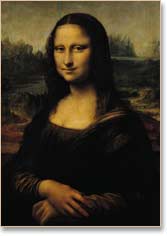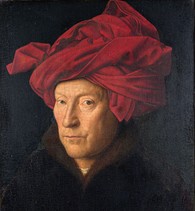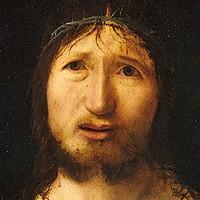Renaissance Portraits
Portrait Paintings of the Italian and Netherlandish
Renaissance.
MAIN A-Z INDEX - A-Z of PAINTING
|
Renaissance Portraits |
 Mona Lisa (La Gioconda) (1503-5) by Leonardo Da Vinci. |
Renaissance Portraits (c.1400-1550)Portrait art during the period of the Italian Renaissance played second fiddle to history (istoria) painting during the trecento (14th century), quattrocento (15th century) and early cinquecento (16th century). The main preoccupation of Renaissance art throughout this period was the depiction of religious, secular and mythological scenes, whose messages were most suitable for public display in huge murals or monumental sculpture. Even so, a number of Old Masters (eg. Leonardo Da Vinci, and Michelangelo) managed to insert portraits (and self-portraits) into their grand murals. Further North, in Flanders, Holland and Germany, the preference for oils over fresco, as well as a lesser enthusiasm for Greek art, led to more traditional easel-style portraiture. The most famous Italian Renaissance portrait is the Mona Lisa, painted by Leonardo Da Vinci when he was 50. |
 Man in a Red Turban (1433) by Jan Van Eyck, the great Dutch Old Master and leader of the Northern Renaissance. For the Top 50 Portraits, see: Greatest Portrait Paintings. |
 Christ Crowned with Thorns (1470) Metropolitan Museum of Art, NY. By Antonello da Messina. |
Pre-Renaissance Portraits (13th-14th Century) Strongly influenced by Byzantine art from the Eastern Roman centre of Byzantium, Italian art during the Gothic period had a linear flat style featuring bold, powerful compositions, especially in the portrayal of the Passion of Christ. Then, in the proto-Renaissance period, Giotto di Bondone began painting rounded, more realist faces and figures. His fresco painting, The Lamentation of Christ (c.1305) included several portraits of Christ, the Holy Mother Mary and the Apostles, which - while still idealized in the Byzantine style - are painted more realistically, with more modern features and human feelings. While not a portraitist, as such, Giotto's faces and his more realistic style of painting led directly to the naturalism of the Early Renaissance. |
|
WORLD'S TOP PORTRAITURE |
Growth in Portrait Painting The mercantile prosperity of Italian city states and certain North European ports, led directly to the artistic upsurge commonly known as the Renaissance. From this time on, in addition to Papal commissions for murals, statues and other artworks, wealthy rulers and citizens across Europe became significant patrons of the visual arts, especially portraits. Italian Renaissance Portraits (c.1420-1520) Its worth noting that four principles underlined Early Renaissance painting, including portraiture: an enormous reverence for Classical Greek Antiquity; a faith in the nobility of Man (Humanism); the mastery of linear perspective (depth in a painting); and an overriding respect for naturalistic figure drawing and figure painting of the human form, in line with the supremacy of disegno over colorito. These principles are exemplified in early Renaissance masterpieces like the dreamy, contemplative sculpture David by Donatello (c.1440s); The sad-faced heroine in The Birth of Venus (c.1485) by Botticelli; the stylish group portrait of Ludovico Gonzaga - see Camera degli Sposi frescoes, by Mantegna; the sweet Old Man with a Young Boy (1490) by Domenico Ghirlandaio; the supremely graceful Lady with an Ermine (Portrait of Cecilia Gallerani) (1490), and Mona Lisa (1503-6) by Leonardo Da Vinci. High Renaissance jewels include: Michelangelo's compelling faces in his Genesis Fresco (1508-12) and Last Judgment fresco (1536-41) on the ceiling and wall of the Sistine Chapel in Rome - possibly the greatest series of murals in the history of art; portraits by other famous artists include: Duke Federico da Montefeltro and His Spouse Battista Sforza (c.1466) by Piero della Francesca; St Sebastian (c.1495) by Perugino; Ecce Homo (1500) by Andrea Mantegna; Portrait of Doge Giovanni Mocenigo (1478) by Gentile Bellini, and Doge Leonardo Loredan (c.1500) by Giovanni Bellini; the subtle Portrait of Baldassare Castiglione (1514-15) and Pope Leo X with Cardinals (1518) by Raphael; Portrait of Pope Clement VII (1526) by Sebastiano del Piombo (1485-1547). For more information about portraiture and its exponents in Venice, see: Venetian Portrait Painting (c.1400-1600). In Florence, Late Renaissance portraiture was exemplified by Agnolo Bronzino (1503-1572), whose icy portraits perfectly captured the arrogance of the Florentine ruling class. See, for instance, his Portrait of Lucrezia Panciatichi (1540, Uffizi Gallery, Florence). |
|
Northern Renaissance Portraits (c.1420-1520) The upsurge in artistic activity among Dutch and Flemish painters during the fifteenth century, commonly called the Northern Renaissance, was not influenced especially by ancient Greek art. Instead, it was more pragmatic, more down to earth and based on two principles. First, its discovery of oil paint, permitting endless reworking of the picture and thus tremendous clarity of detail; second, its appreciation of linear perspective and other techniques like 'the convex mirror' and subtle shading. If the Italian Renaissance is characterized by an unworldly idealism, the artists of Northern Europe created clear-eyed, dispassionate paintings whose realism exceeded that of many Italian virtuosi. Masterpieces of the Dutch, Flemish and German schools include: The Arnolfini Portrait (1434) and A Man in a Red Turban (1433) by Jan van Eyck; numerous 'selfies' like Self Portrait with Fur Collar (1500) by Albrecht Durer (1500-20); and a series of masterpieces by Hans Holbein (1497-1543) including: Erasmus of Rotterdam (1523), Sir Thomas More (1527); Lady with a Squirrel and a Starling (1528); The Merchant Georg Gisze of Danzig (1532); Thomas Cromwell (1532-4); The Ambassadors (1533) and Portrait of Henry VIII (1536). For the next period in the history of portraiture, see: Baroque Portraits. |
|
• For more about the different types
of painting (portraits, landscapes, still-lifes etc) see: Painting
Genres. ENCYCLOPEDIA OF ART |